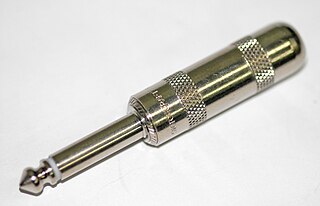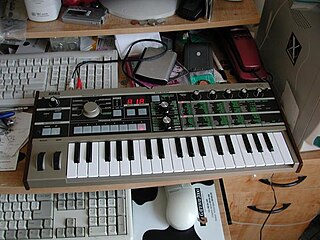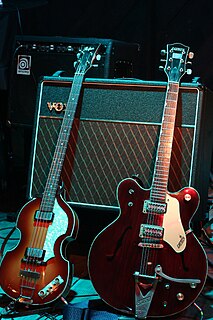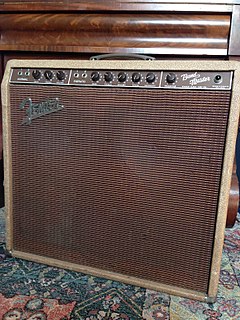
An effects unit or effectspedal is an electronic device that alters the sound of a musical instrument or other audio source.
Distortion is the alteration of the original shape of something. In communications and electronics it means the alteration of the waveform of an information-bearing signal, such as an audio signal representing sound or a video signal representing images, in an electronic device or communication channel.

Modular synthesizers are synthesizers composed of separate modules of different functions. The modules can be connected together with patch cords, a matrix patching system, or switches by the user to create a patch. The output (voltages) from the modules may function as (audio) signals, control voltages, or logic/timing conditions. Typical modules are oscillators, filters (spectrum), amplifiers/gates (amplitude) and Envelope generators.

In sound recording and reproduction, and sound reinforcement systems, a mixing console is an electronic device for combining sounds of many different audio signals. Inputs to the console include microphones being used by singers and for picking up acoustic instruments, signals from electric or electronic instruments, or recorded music. Depending on the type, a mixer is able to control analog or digital signals. The modified signals are summed to produce the combined output signals, which can then be broadcast, amplified through a sound reinforcement system or recorded.

A phone connector, also known as phone jack, audio jack, headphone jack or jack plug, is a family of electrical connectors typically used for analog audio signals.

An instrument amplifier is an electronic device that converts the often barely audible or purely electronic signal of a musical instrument into a larger electronic signal to feed to a loudspeaker. An instrument amplifier is used with musical instruments such as an electric guitar, an electric bass, electric organ, synthesizers and drum machine to convert the signal from the pickup or other sound source into an electronic signal that has enough power, due to being routed through a power amplifier, capable of driving one or more loudspeaker that can be heard by the performers and audience.

A guitar amplifier is an electronic device or system that strengthens the weak electrical signal from a pickup on an electric guitar, bass guitar, or acoustic guitar so that it can produce sound through one or more loudspeakers, which are typically housed in a wooden cabinet. A guitar amplifier may be a standalone wood or metal cabinet that contains only the power amplifier circuits, requiring the use of a separate speaker cabinet–or it may be a "combo" amplifier, which contains both the amplifier and one or more speakers in a wooden cabinet. There is a wide range of sizes and power ratings for guitar amplifiers, from small, lightweight "practice amplifiers" with a single 6" speaker and a 10 watt amp to heavy combo amps with four 10” or four 12" speakers and a powerful 100 watt amplifier, which are loud enough to use in a nightclub or bar performance.

A sound reinforcement system is the combination of microphones, signal processors, amplifiers, and loudspeakers in enclosures all controlled by a mixing console that makes live or pre-recorded sounds louder and may also distribute those sounds to a larger or more distant audience. In many situations, a sound reinforcement system is also used to enhance or alter the sound of the sources on the stage, typically by using electronic effects, such as reverb, as opposed to simply amplifying the sources unaltered.

The ARP Odyssey is an analog synthesizer introduced in 1972. Responding to pressure from Moog Music to create a portable, affordable "performance" synthesizer, ARP Instruments, Inc. scaled down its ARP 2600 synthesizer and created the Odyssey, which became their best-selling synthesizer model.

The microKORG is a MIDI-capable virtual analog synthesizer/vocoder from Korg featuring DSP analog modelling. The synthesizer is built in such a way that it is essentially a Korg MS-2000 with programmable step arpeggiator, a less advanced vocoder, lack of motion sequencing, lack of an XLR microphone input, and in a smaller case with fewer real-time control knobs.

The Korg MS2000 is a virtual analog synthesizer produced by the Japanese electronic musical instrument manufacturer Korg.

The Vox AC30 is a guitar amplifier manufactured by Vox. It was introduced in 1958 to meet the growing demand for louder amplifiers. Characterised by its "jangly" high-end sound it has become widely recognized by British musicians and others.

A bass amplifier or "bass amp" is a musical instrument electronic device that uses electrical power to make lower-pitched instruments such as the bass guitar or double bass loud enough to be heard by the performers and audience. Bass amps typically consist of a preamplifier, tone controls, a power amplifier and one or more loudspeakers ("drivers") in a cabinet.

The Fender Twin and Twin Reverb are guitar amplifiers made by Fender Musical Instruments Corporation. The Twin was introduced in 1952, two years before Fender began selling Stratocaster electric guitars. The amps are known for their characteristically clean tone.

T-Rex ApS is a manufacturer of handmade electric guitar effects pedals.

The Yamaha CS2x is a sample-based synthesizer released by the Yamaha Corporation in 1999. The CS2x is designed for maximum real-time control, according to Yamaha. It is the successor of the very successful Yamaha CS1x. Enhancements include 64-note polyphony, a bigger sample ROM and a 24 dB/oct LPF/HPF filter. The CS acronym stands for Control Synthesizer.

The Fender Bandmaster was a musical instrument amplifier made by Fender. It was introduced in 1953 and discontinued in 1974. Some early models had both a microphone input and instrument inputs. Beginning in 1960, Bandmaster amps were equipped with a vibrato effect. In the 2000s, vintage Bandmaster amps remain in use by blues, Americana and rock and roll bands.

The Korg PS-3300 is a polyphonic analog synthesizer, produced by Korg between 1977 and 1981.

Tube sound is the characteristic sound associated with a vacuum tube amplifier, a vacuum tube-based audio amplifier. At first, the concept of tube sound did not exist, because practically all electronic amplification of audio signals was done with vacuum tubes and other comparable methods were not known or used. After introduction of solid state amplifiers, tube sound appeared as the logical complement of transistor sound, which had some negative connotations due to crossover distortion in early transistor amplifiers. The audible significance of tube amplification on audio signals is a subject of continuing debate among audio enthusiasts.
The Fender Pro was an instrument amplifier manufactured by Fender Electric Instruments from 1946 to 1965. It was characterized by its dual 6L6-family power tubes and single 15" speaker, with output power increasing from 18 watts up to 40 watts over its production run. The Pro was replaced in the Fender lineup by its offspring the Pro Reverb.


















